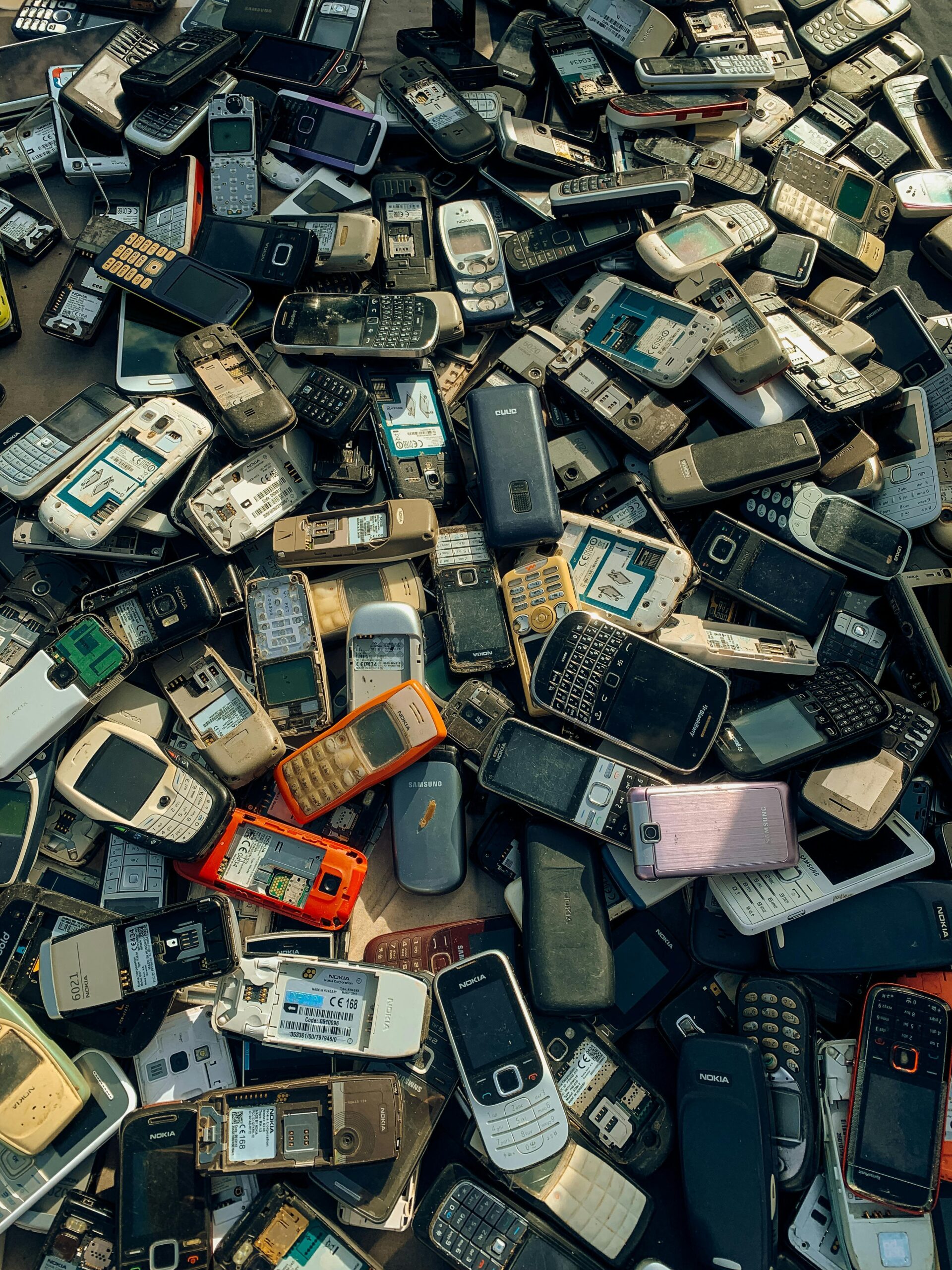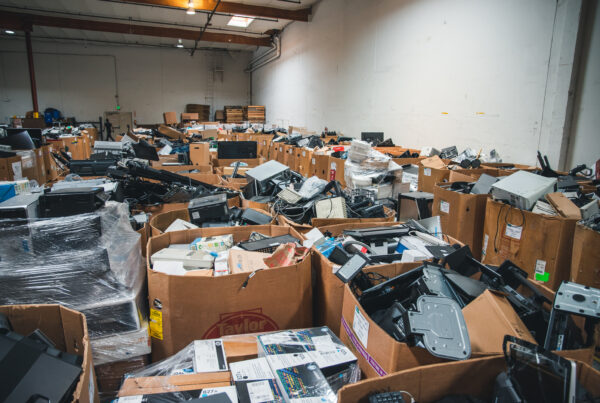So many people don’t know how to properly dispose of electronic devices when they are no longer useful. The average American household owns 24 consumer electronics products, according to the Consumer Technology Association. And humans generate around 62 million tons of electronic waste worldwide annually. That’s like throwing away over 69 million laptops every single day!
Did you know that according to the WHO, throwing away old electronics is actually illegal in 25 U.S. states and over 80 countries? The reason for that is because that stack of old phones cluttering your drawer and the laptop you replaced last year are a part of a growing environmental crisis. Now, proper electronics disposal and electronics recycling have become urgent necessities.
Only 22.3% of global e-waste gets properly recycled, meaning your next disposal decision could literally be breaking the law. Whether you’re finally tackling that home office cleanout or managing corporate IT asset replacement, understanding your options can transform environmental waste into community empowerment. But first, you need to know what’s actually at stake when you choose convenience over responsibility.
Table of Contents
- Why Is It Bad to Throw Away Electronics?
- How Do I Get Rid of My Old Electronics? Common E-Waste Disposal Methods
- Should I Donate my Technology?
- Why You Should Donate Technology to Human-I-T
- Keep e-waste out of the landfills and bodies by donating your electronics today!
Why Is It Bad to Throw Away Electronics?
There are steep fines for improper e-waste disposal
Tossing that broken tablet in your office trash bin is environmentally irresponsible, yes. But it could also land you with hefty fines. The 25 states that have explicitly banned electronics from landfills affect 65% of the American population. New York slaps violators with $100 fines per incident, while Illinois imposes $25 penalties for first-time offenders. Connecticut, Indiana, New Hampshire and Vermont are also among the states that ban electronics from trash bins. Companies big and small aren’t immune either. Costco, Walgreens, and Telecom have all faced substantial government penalties for employee negligence in e-waste handling. As a matter of fact, Target has paid millions in penalties for improper hazardous material disposal.
There are significant data security risks from simply disposing of electronics
Standard e-waste disposal methods offer zero data security guarantees. That means you’re leaving personal information, passwords, and financial records completely accessible to anyone willing to dig. Healthcare organizations, legal firms, and financial institutions face serious compliance violations when client data ends up improperly disposed of. Even seemingly harmless devices store fragments of sensitive information that identity thieves actively seek out. And most people don’t realize that simply deleting files doesn’t actually remove data from hard drives. This makes every carelessly discarded device a potential goldmine for cybercriminals hunting through electronic graveyards. It’s not a safe way to dispose of electronic devices.
Improper e-waste disposal harms the environment
Electronic waste makes up just 2% of landfill mass yet accounts for 70% of all toxic materials buried underground. Mercury from computer monitors seeps into groundwater, causing muscle weakness and memory problems in people in nearby communities. Beryllium oxide from computer towers creates chronic lung diseases. And sulfur in batteries damages kidneys and hearts permanently. Lead, cadmium, and chromium—heavy metals lurking inside everyday devices—leach through soil layers, contaminating drinking water for decades. It’s a health nightmare.
How Do I Get Rid of My Old Electronics? Common E-Waste Disposal Methods
Electronics Recycling is Not Foolproof
Most people assume electronics belong in recycling bins, but this creates unexpected hazards. It’s well-intentioned but the second most unsafe way to dispose of electronic devices. Broken devices contaminate entire batches of recyclable materials, while manual sorting workers face safety risks from sharp fragments and toxic exposure. Basically, you think you’re doing a good thing by tossing your electronics in a recycling bin. But it turns out it’s not that helpful.
Even legitimate recycling facilities struggle with fundamental problems. Energy-intensive shredding processes create substantial carbon footprints. And functional devices get unnecessarily destroyed instead of getting a second life with another person who may need it. And unbeknownst to most well-intentioned folks, much “recycled” e-waste gets exported to developing countries with minimal environmental protections, poisoning local communities.
Is it worth it to donate old technology?
Well, the short answer is yes. Donating to a trustworthy certified organization is the best way to dispose of electronic devices you no longer need or use. Preparing your device for donation is something you should do even if you’re recycling it. And technology donation addresses every disposal limitation while creating social impact. Certified organizations like Human-I-T extend device lifespans by connecting working technology to the over 100 million Americans lacking adequate digital access. They also provide secure data destruction with verification documentation that exceeds recycling protections. This approach transforms waste into community empowerment tools while maintaining highest security standards.
The question then becomes: How do you know if your device qualifies for donation?
Should I Donate my Technology?
When Your Device Qualifies for Donation
Age serves as the main factor for donation eligibility. Devices generally less than five years old keep enough processing power for modern applications needed for education and employment. Your functionality checklist should verify that the device:
- Powers on reliably, displays properly on screens
- Runs current operating systems like Windows 10/11 or recent macOS
- Maintains reasonable battery life for portable devices.
This ensures your old electronics can be turned into tools for accessing education, job opportunities, and essential healthcare services for others.
When should I recycle my electronics?
Devices that won’t power on, suffer broken screens, or experience major hardware failures require certified recycling rather than donation. However, these non-functional devices still contain valuable components and materials that responsible recyclers can recover through proper channels, preventing toxic materials from entering landfills while reclaiming precious metals for manufacturing.
Why You Should Donate Technology to Human-I-T
Human-I-T makes it simple for individuals and organizations to safely dispose of electronic devices. We’re certified ITAD providers and recyclers. So what can’t be refurbished and donated gets responsibly and sustainably recycled.
Individual donors can call 888-391-7249 or visit human-i-t.org, where Human-I-T provides prepaid shipping boxes or convenient facility drop-off locations. Organizations benefit from professional on-site pickup services using GPS-tracked trucks with complete documentation throughout transport. Every donation receives industry-leading data destruction that completely wipes your personal information. Think of it as digital shredding that makes recovery impossible, even for experts with specialized software.
Complete Handling and Documentation
Human-I-T’s certified facilities employ background-checked staff and advanced security systems, ensuring professional handling from collection through community distribution. You receive official certificates confirming your data has been completely destroyed, plus tax-deductible donation receipts for your records. Refurbished devices get fresh operating system installations and quality testing before reaching families who gain access to digital literacy training and ongoing technical support.






